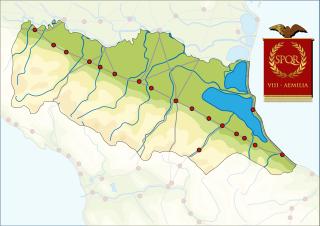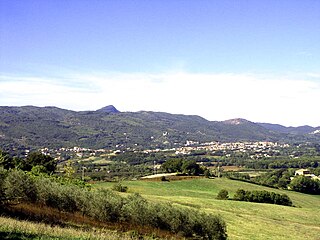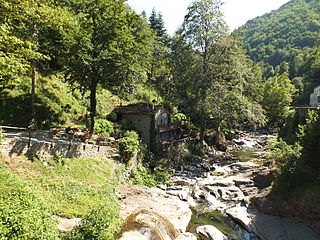
The geography of Italy includes the description of all the physical geographical elements of Italy. Italy, whose territory largely coincides with the homonymous geographical region, is located in southern Europe and comprises the long, boot-shaped Italian Peninsula crossed by the Apennines, the southern side of Alps, the large plain of the Po Valley and some islands including Sicily and Sardinia. Italy is part of the Northern Hemisphere. Two of the Pelagie Islands are located on the African continent.

The Apennines or Apennine Mountains are a mountain range consisting of parallel smaller chains extending c. 1,200 km (750 mi) along the length of peninsular Italy. In the northwest they join with the Ligurian Alps at Altare. In the southwest they end at Reggio di Calabria, the coastal city at the tip of the peninsula. Since 2000 the Environment Ministry of Italy, following the recommendations of the Apennines Park of Europe Project, has been defining the Apennines System to include the mountains of north Sicily, for a total distance of 1,500 kilometres (930 mi). The system forms an arc enclosing the east side of the Ligurian and Tyrrhenian seas.

The Sangro is a river in eastern central Italy, known in ancient times as Sagrus from the Greek Sagros or Isagros, Ισαγρος.

The Via Aemilia was a trunk Roman road in the north Italian plain, running from Ariminum (Rimini), on the Adriatic coast, to Placentia (Piacenza) on the River Padus (Po). It was completed in 187 BC. The Via Aemilia connected at Rimini with the Via Flaminia, which had been completed 33 years earlier, to Rome.

Gran Sasso d'Italia is a massif in the Apennine Mountains of Italy. Its highest peak, Corno Grande 2,912 metres (9,554 ft), is the highest mountain in the Apennines, and the second-highest mountain in Italy outside the Alps. The mountain lies within Gran Sasso e Monti della Laga National Park.

The province of Bologna was a province in the Emilia-Romagna region of Italy. Its provincial capital was the city of Bologna. The province of Bologna covered an area of 3,702.32 square kilometres (1,429.47 sq mi) and had a total population of 1,004,323 inhabitants as of 31 December 2014, giving it a population density of 271.27 inhabitants per square kilometre. It was replaced by the Metropolitan City of Bologna starting from January 2015.

The province of Caserta is a province in the Campania region of Italy. Its capital is the city of Caserta, situated about 36 kilometres (22 mi) by road north of Naples. The province has an area of 2,651.35 square kilometres (1,023.69 sq mi), and had a total population of 924,414 in 2016. The Palace of Caserta is located near to the city, a former royal residence which was constructed for the Bourbon kings of Naples. It was the largest palace and one of the largest buildings erected in Europe during the 18th century. In 1997, the palace was designated a UNESCO World Heritage Site.

Monti della Laga is a mountain range in the central Apennines of Italy. Their ruggedness and inaccessibility makes them one of the lesser known areas of the Italian peninsula.

Pievepelago is a comune (municipality) in the Province of Modena in the Italian region of Emilia-Romagna in the heart of the northern Apennine Mountains. Situated on the Scoltenna River, in a mountain valley, it is a tourist resort crossed by the Via Vandelli.

Campo Imperatore is a mountain grassland or alpine meadow formed by a high basin shaped plateau located above Gran Sasso massif, the largest plateau of Apennine ridge. Known as "Little Tibet", it is located in Gran Sasso e Monti della Laga National Park, near L'Aquila, Abruzzo, Italy.

The Reno is a river of Emilia-Romagna, northern Italy. It is the tenth longest river in Italy and the most important of the region apart from the Po.
Limentra may refer to two rivers in central-northern Italy:

Monte Cusna is the 2nd highest peak in the northern Apennines after Monte Cimone. But, it is much steeper and more remote.

The Alburni are an Italian mountain range of the Province of Salerno, Campania, part of the Apennines. Due to their geomorphology, they are popularly known as the "Dolomites of Campania" or of Southern Italy. The highest mountain is the Panormo. Its second name, Alburno, gives the name to the whole range.

The Metropolitan City of Bologna is a metropolitan city in the Emilia-Romagna region of Italy. Its capital is de facto the city of Bologna, though the body does not explicitly outline it. It was created by the reform of local authorities and established by the Law 56/2014, replacing the province of Bologna. It has been operative since 1 January 2015.

The Limentra di Sambuca is a mountain river in Italy, a right tributary of the Reno. It rises from Monte la Croce in the Apennine Mountains, elevation about 1,319 metres (4,327 ft), and passes through Sambuca Pistoiese. It has a length of 19.4 kilometres (12.1 mi) and flows into the Reno near Ponte della Venturina, near the border between Tuscany and Emilia-Romagna. Near Pàvana is a dam with a capacity of 900,000 cubic metres (32,000,000 cu ft). The waters are also used for the aqueduct serving Pistoia.

Neccio, also called niccio, ciaccio or cian, is a galette based on chestnut flour, typical of some mountain zones of Tuscany and Emilia, in Italy, and of the island of Corsica, in France.
The regional park of the Suviana and Brasimone lakes is a protected natural area established in 1995 which rises on the Bolognese Apennines, in Emilia-Romagna, on the border with Tuscany. The area is located around two large artificial basins built starting from the early twentieth century for hydroelectric purposes, Lake Suviana, surrounded by a thick pine forest, and the Brasimone basin, with grassy banks.

Bargi hydroelectric power station is a hydroelectric power station in the north-central part of Italy, in the Emilia-Romagna region. It uses reservoirs created in the confluence of two right tributaries of the river Reno, which flows into the Adriatic Sea north of Ravenna).
















